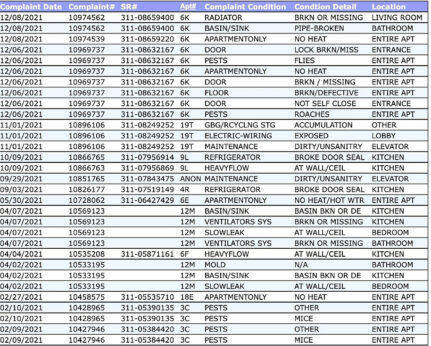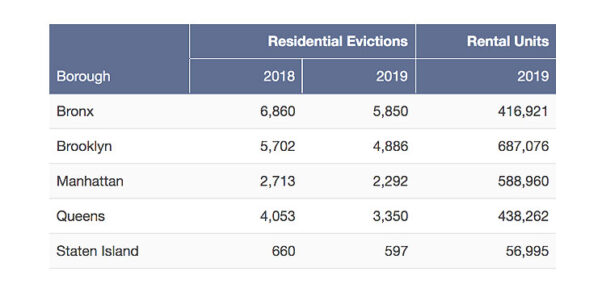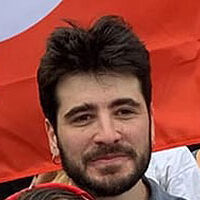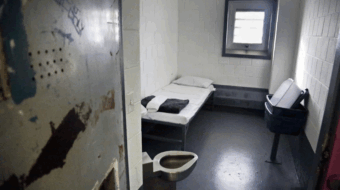
BRONX, N.Y. – On Sunday, Jan. 9 at 11:00 a.m. a vicious fire tore through the Twin Parks, NorthWest building, located at 333 E.181st street, in the Bronx. The fire started in unit 3M after a heater was allegedly left on for three days. After the smoke filled the apartment and the fire department was notified, 17 individuals were left dead, including eight children.
The history of the housing development, from the long list of complaints from tenants to the oppressive economic conditions in the Bronx overall, reveals that this disaster was not an individual mistake from a tenant, but an unfortunate and eventual result of capitalist greed.
Twin Parks is made up of four developments, Twin Parks Northwest, Northeast, Southwest, and Southeast. Originally built in the early 1970s, these Public housing units were designed as mixed income housing. The original plan consisted of developing Twin Parks with the collaboration of the Twin Parks Association, a group of religious community organizations that wanted to assist in finding low, moderate, and middle-income apartments. However, the head of the Twin Parks Association was unable to secure funding, resulting in relinquishing community control and changing ownership of the property into private hands starting in 1973.
With the transition from community control (with the Twin Parks Association) to the hands of private developers, there were and continue to be increasingly negative effects on the lives of the tenants. In 2013 the building was sold to Cammeby’s International Group, owned by mogul Rubie Schron. He received $25 million in state financing specifically for the purpose of fixing and renovating the apartments.
In 2007 Schron owned 1 billion dollars in assets. Today he continues to invest in many buildings including commercial real estate, Mitchell Lama Apartments and Nursing Homes. In 2020, 8 buildings were sold to a consortium named Bronx Park Phase III Preservation LLC, a group of three developing agencies, Belveron Partners, LIHC Group, and The Camber Property Group. The total paid for 8 buildings amounted to $166 million, while the one Twin Parks building was bought for $25 million. This valued each of the 120 apartments inside at $206,000. This is about one-third less than the price of homes in the Bronx. To this day, Bronx Park Phase III Preservation LLC continues to manage Twin parks and it was under their management at the time of the deadly fire.
Residents complained before the fire
Starting under the management of Rubie Schron, a number of documented complaints were made from the tenants at 333 East 181st. In 2014 there were documented accounts of Pests, flaws with electric-wiring, and maintenance issues in the units. Many of these instances were reported up until the month prior to the fire. New York City Housing Authority (NYCHA) was ordered to inspect 12 of 120 units because they provided tenants with rent vouchers.

“Five of the apartments — nearly half of those checked — failed NYCHA’s inspections, which took place between 2019 and 2021. Two of the units were on the third floor — the same as the apartment where the fire, sparked by a space heater, broke out.” Inspectors for HPD cited the building six times between 2013 and 2019 for failing to keep all of the building’s self-closing doors in working order — a problem that the landlord sometimes let sit for three years. Additionally, the building received at least four complaints last year of units being without heat.
New York City Mayor Eric Adams said that if there’s one thing to take away from this tragedy, it is to “Close the door…This painful moment can turn into a purposeful moment as we send the right message of something simple as, ‘closing the door.’”
But the reality is that the individual in this situation is not the actual cause of the fire. The cause of the destructiveness of this fire was the door being left open. However, the doors in these buildings are supposed to close automatically.
After a destructive 2017 Bronx fire killed 13 people, a new 2018 law stated that “self-closing doors were required in multiple dwelling units under state code. When the city law was passed, the violation penalty increased from Class B to Class C, meaning HPD can take immediate action to fix the hazard if the landlord does not comply. Mayor Adams may find it easier to place the blame on individuals, rather than look at the effectiveness of the public housing structure. Even after extensive investigations from NYCHA and HPD, as well as Schron being given $25 million solely for repairs, this disaster occurred.
A spokesman for the current ownership group stated, “Since the moment we took over the property, we have worked tirelessly to improve conditions for our residents.” In reality, this is the exact opposite of the truth. Complaints from the tenants have been met with no action because the housing corporation does not hold any stake in attending to residents’ complaints. This disaster shows the difference in the interests of Belveron Partners, LIHC Group and The Camber Property Group, and the community living in Twin Parks. These disasters are at the core of the current housing crisis and at its center is capitalist violence against Black and Hispanic working-class families in the Bronx.
Camber Property Group is currently the fastest growing developer of affordable housing in the city. In 2020, Rick Gropper and others bought the $25 million building as a future investment. He bought this property, among eight other buildings, to have access to tax credits and accumulate wealth over time.
Rick Gropper was also announced as being a member of Mayor Adams’s housing transition team, connecting the current mayor with the landlord who owned the Twin Parks building. Adams, who once said “I am real estate,” was a landlord with his own baggage of investigations by the Department of Buildings for a possible illegal conversion of a basement unit into his purported residence. The relationship between Gropper and Adams represents an allegiance between the individual investor and the mayor whose shared interests protect him.
Under the system, Rick Gropper and other landlords are able to invest in property for the purpose of accumulating wealth. The state allocated $25 million dollars to remedy the housing facilities, yet there were ongoing complaints of living conditions. The landlords were not making sure the heat was on, the roaches and mice were gone, or the doors were working for residents.
For Bronx Park Phase III Preservation LLC, the intention is to accumulate wealth, while for the tenants the primary concern is to have a safe place to live with basic amenities. The landlord must spend the least amount of money on repairs in order to make the most profit for his investment.
“The rent of land is established as a result of the struggle between tenant and landlord. We find that the hostile antagonism of interests, the struggle, the war is recognized throughout the political economy as the basis of social organization.”
As Karl Marx details above, with the privatization and renting of land, there will inevitably be a struggle between the landlord and renter, as a result of antagonistic interests. In this case, Rick Gropper accumulated profits from simply receiving rent and tax credits. Gropper did not improve the conditions of the building, even when the conditions were in disarray. As he accumulates more money through doing nothing but owning a building and charging working-class people to rent, a working person lives in worse and worse conditions.
Victim of economic warfare
The pandemic has shown that more than any other borough the Bronx has been the victim of economic warfare. This extends from access to affordable housing to access to healthcare and job opportunities. The industries in the Bronx often reflect the unequal relationship between working people and the industries which inhabit the borough. For example, the pandemic has illuminated how interconnected Bronx employment is with the healthcare industry. A total of 25.9% of individuals living in the Bronx work in healthcare. During the pandemic, the borough suffered major losses because of hospitals’ own neglect in taking care of their staff. In some hospitals, in order to recuperate lost profit from the pandemic, hospitals refused to hire more nurses and chose to create a dangerous atmosphere for workers. According to one source:
“[Hospitals are] Lacking nurses, technicians, patient care assistants, transporters, and so many ancillary staff members. This increases the burden and responsibilities on the rest of us to do tasks that are outside of our purview — sometimes even unsafe for ourselves and patients — which then builds up resentment, burnout, and loss of dignity.”
The effects of the pandemic on healthcare workers are just one symptom of difficult health conditions for the residents. The Bronx contains 7 of the top 10 neighborhoods for asthma rates. There have been increasingly high levels of asthma, with the South Bronx being often called “Asthma Alley.” This has been further exemplified by aspects of industry using the Bronx as a dumping ground. Historically the Bronx has acted as a waste ground for fossil fuel, resulting in the residents experiencing the devastating results. Co-founder of the community organization South Bronx Unite, Mychal Johnson, put it this way:
“For decades we’ve been the dumping location for fossil fuel power plants, waste transfer stations, heavy diesel truck intensive business, and highways that serve other neighborhoods. We were forced to shoulder the burden of these businesses for supposed economic development, but we never saw it trickle down, we only saw the health effects.”
This unequal exchange also applies to housing within the Bronx. Before the pandemic, the Bronx had the highest number of pending, scheduled, or executed evictions of any borough. This comes at a high cost considering the high percentage of renters, with 80% of all Bronx households being rented. This also overlaps with the healthcare sector being a primary way to gain employment in the Bronx job market.
 Although the number of 2018 and 2019 evictions in the Bronx were the highest, the number of rental units was the lowest. This shows that on average Bronx renters are far more likely to be at risk of being evicted from their homes. The percentage of evictions is out of proportion to the number of rental units. This corresponds with higher rates of unemployment during the pandemic. The Bronx reached an almost 25% unemployment rate during the pandemic. The combination of high unemployment, dilapidated living conditions, lack of care for medical professionals, high eviction rates, and a history of environmental racism all coalesce into a disastrous situation for working-class people in the Bronx.
Although the number of 2018 and 2019 evictions in the Bronx were the highest, the number of rental units was the lowest. This shows that on average Bronx renters are far more likely to be at risk of being evicted from their homes. The percentage of evictions is out of proportion to the number of rental units. This corresponds with higher rates of unemployment during the pandemic. The Bronx reached an almost 25% unemployment rate during the pandemic. The combination of high unemployment, dilapidated living conditions, lack of care for medical professionals, high eviction rates, and a history of environmental racism all coalesce into a disastrous situation for working-class people in the Bronx.
The threat of both unemployment and dispossession is an essential facet of Capitalist production. Capitalism relies upon a certain number of workers unemployed as a possible labor force to compete for jobs and receive lower wages. In addition, there is a reserve of homeless individuals to threaten the working class with dispossession.
“The overwork of the employed part of the working-class swells the ranks of the reserve, whilst conversely the greater pressure that the latter by its competition exerts on the former, forces these to submit to overwork and to subjugation under the dictates of capital. The condemnation of one part of the working class to enforced idleness by the overwork of the other part, and the converse, becomes a means of enriching the individual capitalists.”
As Karl Marx detailed, the capitalist needs a reserve army of disenfranchised workers in order to enrich and accumulate profit. During the crisis caused by the pandemic, the worker must choose to either be exploited and continue work or be jobless. In the Bronx the workers’ conditions on the job are oppressive, nurses are not given personal protective equipment, they are understaffed and underpaid. They will submit to these conditions and overwork themselves because of the expectation put onto them by the hospital.
Bronx workers must also affirm the employer and the system by overworking and tolerating exploiting working conditions to avoid joblessness. This all results in the further accumulation of profit. In the Bronx, the combination of high unemployment rates with the threat of being homeless during the pandemic presents an impossible choice to the worker. The choice is to continue working in an environment that is destructive for personal health or unemployment.
In every statistic, the Bronx was hit hardest by the pandemic. Why is it the Bronx that has the highest number of pre-pandemic evictions? Why is the Bronx continually hit by air pollution causing deadly asthma? It is because the Bronx was historically not profitable in the context of capitalist economic accumulation.
It is clear that the potential for profit making in the Bronx is shifting in the direction of being greater than ever. The Bronx Park Phase III group is the fastest growing group of public housing in the city. This growth represents a shift in capital in order to expand markets to the Bronx. This expansion represents the accumulation of wealth for landlords like Rick Gropper and Rubin Schron, resulting in future deteriorated living quarters for tenants who live in these buildings.
The 2022 Bronx fire then was not the result of an individual decision by one tenant to not shut a door. Politicians like Eric Adams want to explain the fire this way to draw attention away from the city’s disastrous capitalist housing system. The housing crisis reflects not an individual inability to maintain their residency, but a decision by the State to protect capitalist interests:
“The state is nothing but the organized collective power of the possessing classes, the landowners and the capitalists as against the exploited classes, the peasants and the workers…As long as the capitalist mode of production continues to exist, it is folly to hope for an isolated solution to the housing question or of any other social question affecting the fate of the workers. The solution lies in the abolition of the capitalist mode of production and the appropriation of all the means of life and labor by the working class itself.”
As Fredrich Engels specifies, until the capitalist system itself is addressed, such disasters will continue to occur. As long as landlords like Gropper continue to purchase properties to be used as capital, the quality of life for the individuals inhabiting these buildings becomes worse and worse. The fire is the result of the housing crisis in full effect. It is the result of years of disregard for a borough that is made up of working-class Black and Hispanic residents, and specifically a large Gambian community who was greatly affected by the fire in Twin Parks. It is a combination of the historic disregard for the environment, a loss of essential work jobs (concentrated in the healthcare industry), and lack of access and investment in affordable housing that has created a difficult reality for New Yorkers living in the Bronx.
Still mourning the loss
The community at Twin Parks is still mourning the loss of their loved ones within the community. The 2022 Bronx fire and the devastating conditions leading up to it have shown the disastrous effects of capitalist greed on the Bronx community. However, it has also demonstrated the Bronx community’s ability to respond in solidarity with their neighbors.
The Gambian Youth Organization (GYO), a community based organization of Gambian youth leaders, located in the Bronx, has consistently been present as a source of care and outreach to the victims and community at large. The GYO, working with local organizations such as South Bronx Mutual aid (SBXMA), has been hosting community food distributions many days after the fire. They have set up essential mutual aid networks to provide food and supplies to the victims and community. Hundreds of thousands of material goods have been donated and distributed. Additionally, the GYO recently announced that they are providing temporary housing through Airbnb to victims affected by the fire.
Local religious centers and mosques such as Saqafi Mosque have also been instrumental in storing and distributing food. This effort by the community has been entirely led by local organizations on the ground, in direct communication with victims of the fire to assist with material needs they may have. This has shown the incredible work these groups have done and will continue to do in response to the tragedy.
Though at the same time there are support networks being forged within the community, there is also a need to question why these disasters continually happen in the borough. Mayor Eric Adams wants New Yorkers to idolize the community response, while he refuses to acknowledge that this community effort is the result of the city’s neglect of working people. The Bronx has been subjected to difficult economic conditions for the past 50 years. Community organizations are calling not only for increased resources (such as food and clothing) to deliver to their neighbors but to challenge the insidious nature of the system which could cause these disasters to occur in the future.
The community response has led to numerous South Bronx community actions. From demanding that the landlords of 333 E.181st be held responsible for their neglect of previous tenant complaints, to community members organizing tenant meetings to discuss tenants’ rights, people are responding. Through future organizing, Bronx community organizations will continue to fight against the foundations of capitalist exploitation in housing. They will continue organizing within the community to secure safe and affordable housing units that the working people of the Bronx deserve.
Read The Housing Question, by Frederick Engels.
Available from International Publishers.










